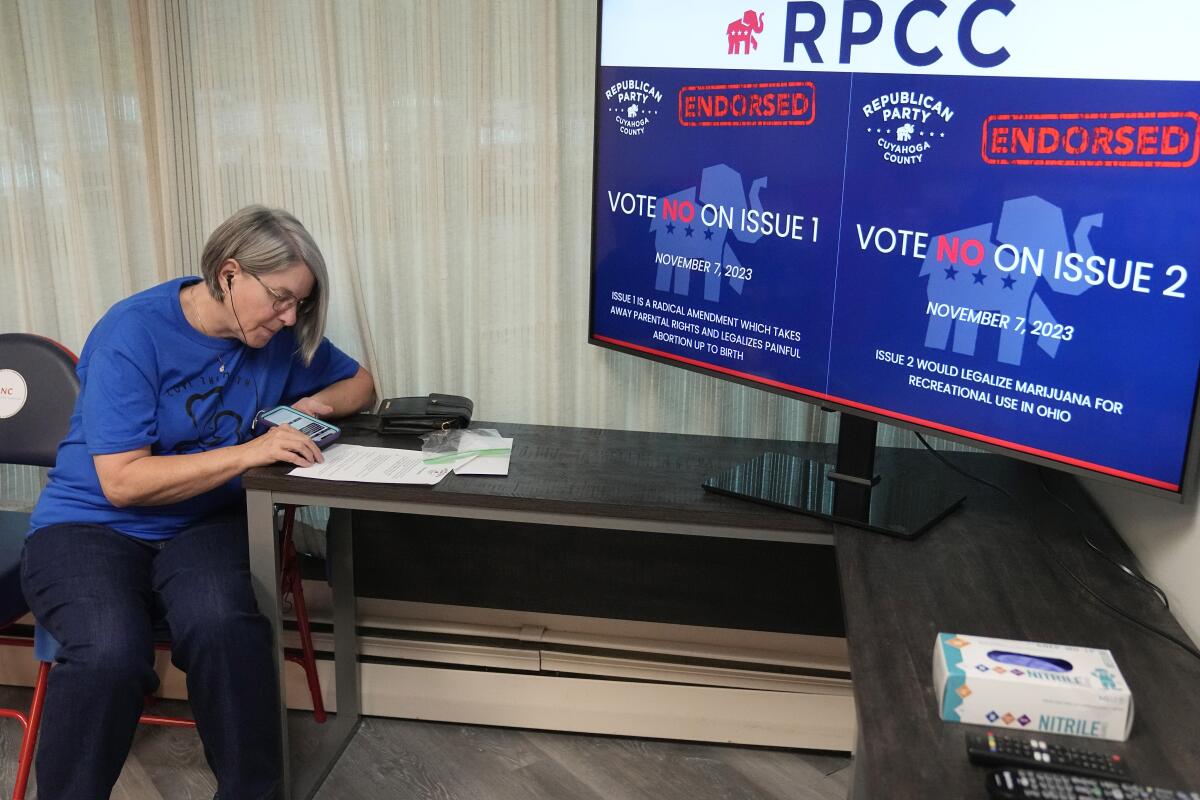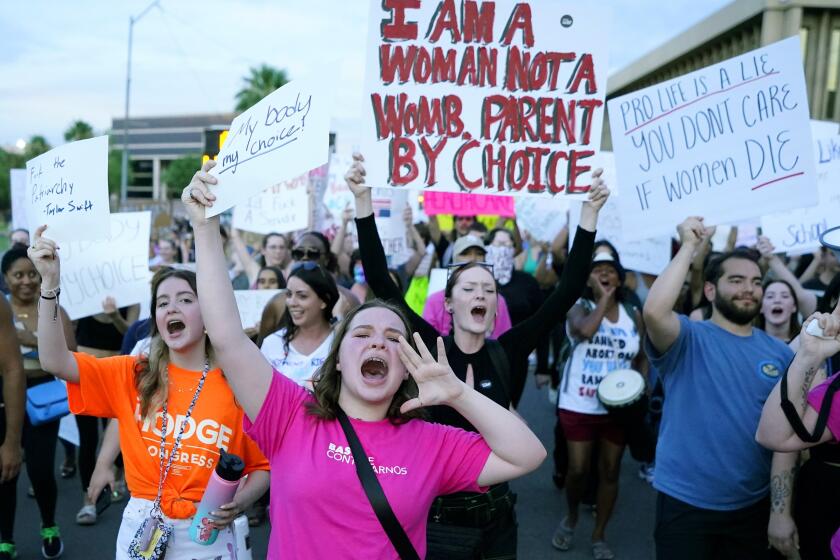Antiabortion groups are at odds on strategies ahead of Ohio vote. It could be a preview for 2024

COLUMBUS, Ohio — Abortion opponents in Ohio are at odds not only over how to frame their opposition to a reproductive rights initiative on the state’s November ballot but also over their longer-term goals on how severely they would restrict the procedure.
The disagreements, roiling the anti-abortion side just six weeks before election day, are providing a window into the challenges the wider movement is preparing to navigate next year. Initiatives to protect reproductive rights are expected in multiple states and abortion will be a central issue in candidate races up and down the ballot.
Scattershot campaign messaging in Ohio hints at some of the internal conflict among members of the broad anti-abortion coalition aligned against the constitutional amendment that seeks to protect abortion access in Ohio.
Russian President Vladimir Putin has released an address marking the one-year anniversary of Moscow’s unilateral annexation of four Ukrainian regions.
Early ads played on voters’ fears by warning that the amendment, known as Issue 1, would be a gateway to teenagers getting abortions and gender-transition surgeries without their parents’ consent. Other efforts focused on advancing legal arguments about the amendment’s specific phrasing, including the meaning of “reproductive health care.”
In its first statewide TV ad, which began airing this past week, the opposition campaign Protect Women Ohio went in yet another direction. It combined clips of former President Trump and President Biden on screen to try to unite Republicans and Democrats against the proposal’s ability to protect abortions into the ninth month of pregnancy, even though health statistics show later-term abortions are a rarity, generally reserved for life-threatening circumstances.
Terry Casey, an Ohio Republican consultant, said the opposition campaign’s reliance on two unpopular politicians in the ad only extends a disjointed approach that ultimately will be unlikely to win the day with voters.
“The key thing I’m looking at is, ‘What’s the message on the no side, and is it clear and understandable?’” he said. “So far, I haven’t seen that, nor that they have the money and resources to define the issue to the 11.5 million people of Ohio.”
Casey said Ohioans United for Reproductive Rights, the coalition advocating a “yes” vote, seems to have developed a consistent message — freedom from government interference in one’s personal reproductive health decisions — and stuck with it. That’s easier to do when you’re on a winning streak, he said.
The U.S. Supreme Court’s ruling last year that overturned Roe vs. Wade kicked the abortion question back to the states. Since then, voters in Democratic and deeply Republican states — California, Kansas, Kentucky, Michigan, Montana and Vermont — have voted to protect abortion rights in one form or another. Abortion rights questions are planned in more than half a dozen states next year.
David Zanotti, president and CEO of the conservative American Policy Roundtable, said “it’s crystal clear” that the abortion rights movement was ready for the high court’s ruling in Dobbs vs. Jackson Women’s Health Organization and that “the anti-abortion community was not.”
“For 50 years, we didn’t have to think about this because the big people in the black robes said it’s not your business,” he said. “Now suddenly, it’s our business.”
Republicans across the country are divided over how to move forward on the issue, particularly because the string of defeats is backed up by public polling that suggests about two-thirds of people in the United States believe abortion should generally be legal. Do Republicans capitalize on the Dobbs decision to push for an “abortionless future,” concede to a patchwork of individual state laws or compromise on federal legislation?
Protect Women Ohio is funded largely by the campaign arm of Susan B. Anthony Pro-Life America, a leading national anti-abortion group. Last spring, the organization enlisted Kellyanne Conway, a pollster and onetime Trump advisor, “to get pro-life candidates on offense in the 2024 election cycle.”
Conway and Marjorie Dannenfelser, Susan B. Anthony’s president, defined what they mean by “pro-life” when they wrote in a Washington Post op-ed that the anti-abortion movement should embrace a minimum standard of banning abortion after the 15th week of pregnancy.
The column appeared after Ohio Republicans’ defeat in an August special election, when the state’s voters resoundingly rejected a proposed amendment that would have made it tougher to pass the abortion measure and other future constitutional changes.
The American Policy Roundtable doesn’t support federal action, after conservatives spent half a century fighting to bring decision-making power on abortion back to the state level. Zanotti said it has chosen to run its own campaign against the Ohio amendment focused on its phrasing and legal reach.
Another major player in the anti-abortion movement, the Catholic Conference of Ohio, is part of the statewide coalition but is also running its own parallel effort opposing the amendment. Executive Director Brian Hickey said that campaign focuses on three points: parental rights, the safety of women and the fact the amendment would allow abortions through all nine months.
“I would place the Catholic Conference as supporting as much human life as possible and as expansive resources as possible to pregnant women, single mothers and young families,” he said. “That includes tax credits, affordable housing, social support, that sort of thing.”
Austin Beigel, president of End Abortion Ohio, does not consider the 15-week policy that Susan B. Anthony is supporting as “pro-life.” He said he has begun referring to himself as an “abortion abolitionist” because he believes the term “pro-life” has become meaningless.
“I don’t use that phrase anymore, because it seems the pro-life movement no longer wants to accomplish the goal of abolishing abortion,” he said. “Somewhere along the line, the various groups began to abandon the idea.”
To groups like his, one date stands out — May 12, 2022. Just days after a draft leaked suggesting the Supreme Court would overturn Roe, but before the court had acted, Louisiana was poised to pass a bill defining abortion as homicide, exposing women to criminal prosecution and prison. More than 75 anti-abortion groups, led by National Right to Life, signed an open letter condemning the legislation.
The president of Ohio Right to Life was among those signing the letter, which Beigel’s group criticized. The divide between the state’s anti-abortion camps widened earlier this year over an effort to introduce a similar bill in Ohio, which would have banned abortions from conception and criminalized the doctors and women involved in them.
That bill was nearing introduction this summer when another anti-abortion activist taking part in the Protect Women Ohio campaign pressured the sponsor to spike it, Beigel said. Their concern was that publicity over the bill would generate backlash and make it harder to defeat the abortion rights amendment, which had just qualified for the fall ballot.
Ohio’s top Republican, Gov. Mike DeWine, is offering yet another message to voters in an effort to bolster the opposition to the constitutional amendment. A staunch Catholic who opposes abortion, DeWine is pledging that if voters defeat the amendment, he will work toward a legislative compromise that “the majority of the people are comfortable with.”
To supporters of abortion rights, the divisions that the Ohio amendment have exposed in the anti-abortion movement are merely “cosmetic,” said NARAL Pro-Choice Ohio Executive Director Kellie Copeland.
She pointed to legislation passed by the Republican-controlled Legislature to ban abortions once fetal cardiac activity is detected, usually around six weeks. With a Republican-majority state supreme court, Copeland said she has no doubts about what Republicans will do if the amendment is defeated.
“No matter who’s taking the lead, or what they’re saying, their goal has been and remains a total ban on abortion with no exceptions,” she said. “What they’re arguing about is strategy, tactics for holding onto voters who are not on their side.”
More to Read
Sign up for Essential California
The most important California stories and recommendations in your inbox every morning.
You may occasionally receive promotional content from the Los Angeles Times.











